The Desktop Kabini Review Part 1: AMD Athlon 5350 (AM1) Tested
by Ian Cutress on April 9, 2014 8:00 AM ESTCPU Benchmarks
Console Emulation – Dolphin Benchmark: link
At the start of 2014 I was emailed with a link to a new emulation benchmark based on the Dolphin Emulator. The issue with emulators tends to be two-fold: game licensing and raw CPU power required for the emulation. As a result, many emulators are often bound by single thread CPU performance, and general reports tended to suggest that Haswell provided a significant post to emulator performance. This benchmark runs a Wii program that raytraces a complex 3D scene inside the Dolphin Wii emulator. Performance on this benchmark is a good proxy of the speed of Dolphin CPU emulation, which is an intensive single core task using most aspects of a CPU. Results are given in minutes, where the Wii itself scores 17.53; meaning that anything above this is faster than an actual Wii for processing Wii code, albeit emulated.
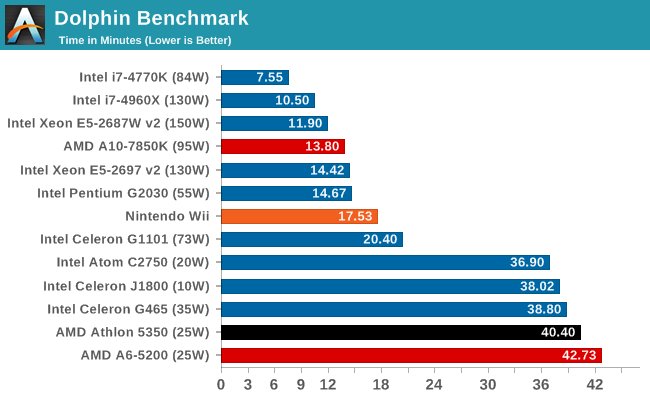
Point Calculations – 3D Movement Algorithm Test: link
3DPM is a self-penned benchmark, taking basic 3D movement algorithms used in Brownian Motion simulations and testing them for speed. High floating point performance, MHz and IPC wins in the single thread version, whereas the multithread version has to handle the threads and loves more cores.
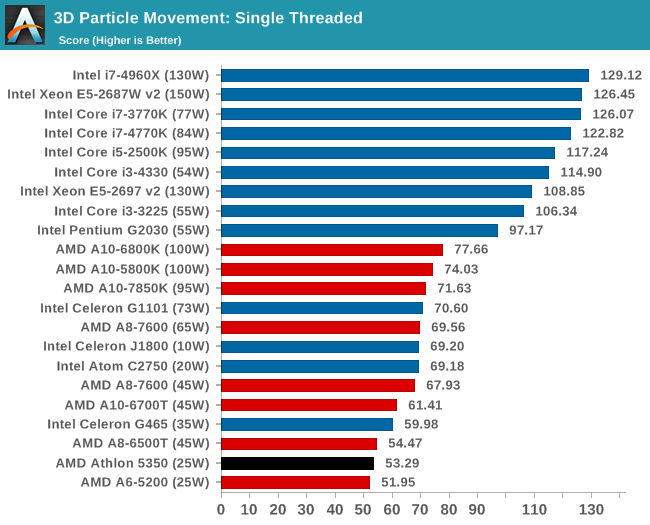
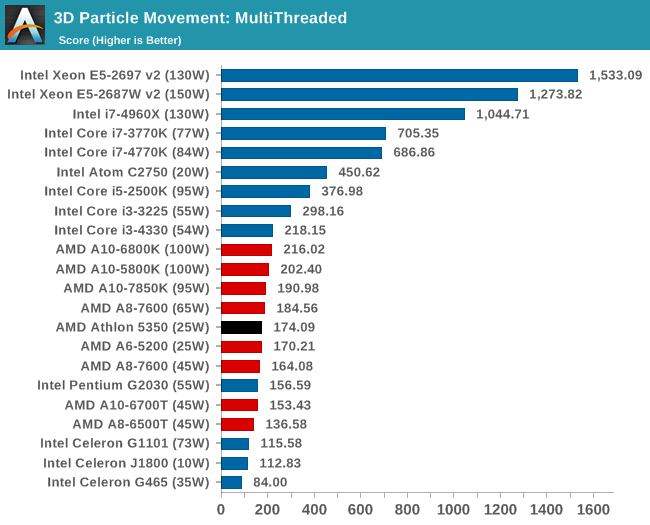
Encryption –TrueCrypt v0.7.1a: link
TrueCrypt is an off the shelf open source encryption tool for files and folders. For our test we run the benchmark mode using a 1GB buffer and take the mean result from AES encryption.
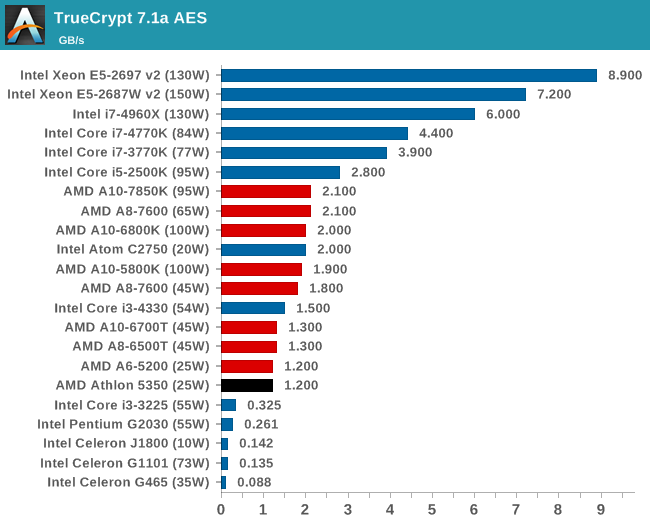
Synthetic – 7-Zip 9.2: link
As an open source compression tool, 7-Zip is a popular tool for making sets of files easier to handle and transfer. The software offers up its own benchmark, to which we report the result.
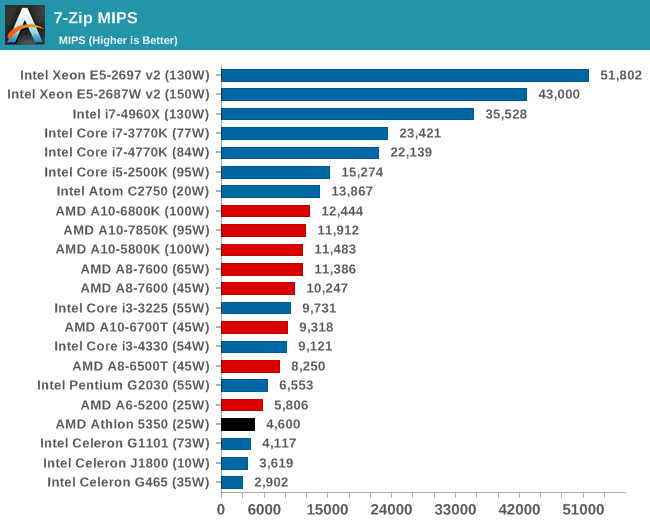
Rendering – PovRay 3.7: link
The Persistence of Vision RayTracer, or PovRay, is a freeware package for as the name suggests, ray tracing. It is a pure renderer, rather than modeling software, but the latest beta version contains a handy benchmark for stressing all processing threads on a platform. We have been using this test in motherboard reviews to test memory stability at various CPU speeds to good effect – if it passes the test, the IMC in the CPU is stable for a given CPU speed. As a CPU test, it runs for approximately 2-3 minutes on high end platforms.
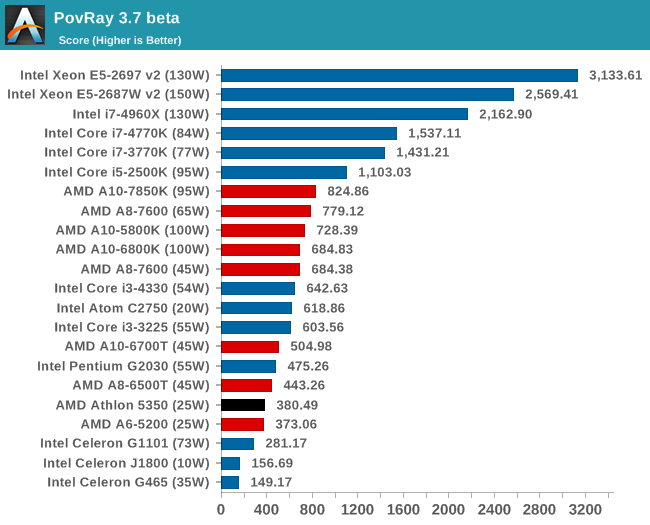










126 Comments
View All Comments
Medallish - Wednesday, April 9, 2014 - link
Indeed, I loved building one, but it's kind of hard to advertise it being insanely cheap, and advertising upgradeability, you are more likely to simply purchase something new entirely when upgrading, if they are able to upgrade AM1 CPU's greatly, like lets say the next Mullins or Beema fits in effortlessly and introduces new stuff like Dual Channel DP 12a, or HDMI 2.0, and it worked on older boards, then I would say AMD had a nice idea, but the question really comes down to, at this price point do people even care about upgradeability?mikato - Friday, April 11, 2014 - link
The good thing is that if/when you do upgrade and get a Beema, you're upgrading both the graphics and the CPU, hopefully both significantly.mrdude - Wednesday, April 9, 2014 - link
I'm actually fond of AMD's APUs and their direction with respect to heterogenous computing (I think it'll succeed even if AMD goes out of business, personally), but I agree with you.Providing a socketed platform is great, but without a clear direction and upgrade path it's all for naught -- and I mean AMD needs to state that Beema will be available on X date and features Y improvements. Nobody with more than a few brain cells buys into a platform that offers nothing outside of 'wait and see.'
AMD also needs to come to grips with the fact that on-die GPUs aren't going to taken seriously until they can provide playable framerates at 1080p without substantially increasing platform cost. Kaveri does the first part very well, but the memory scaling and memory cost issue really hamstring the platform. Pushing for beefier graphics makes sense in the tablet space where Mullins is supposed to make headway, but on the laptop/desktop side it's next-to-worthless unless it can play modern titles at 720p or 1080p at medium settings.
And Kabini desperately needs an aggressive turbo core and dual-channel memory. Kanter's article shows a very potent little microarchitecture, but those two points are really holding it back.
I think Jaguar is a better microarchitecture than Steamroller, but it seems clear to me that AMD isn't giving it the sort of attention that I feel it deserves.
JDG1980 - Wednesday, April 9, 2014 - link
Backtracking on GDDR5 for Kaveri was a big mistake. Without the added memory bandwidth, the iGPU is bottlenecked, and the result is that Kaveri barely offers any improvement over Richland at all.Musafir_86 - Wednesday, April 9, 2014 - link
-It's Mantle time!-On a serious note, please test any GCN 1.1 card (Bonaire & Hawaii), and also GCN 1.0 card with BF4 & Thief in Mantle mode, pretty please! Don't let that ×16 slot go to waste!
Regards.
otherwise - Wednesday, April 9, 2014 - link
Looking at those CPU benchmarks, I would argue if you're even considering using an external GPU with this system you should be looking elsewhere. It's not really cheaper than a low end celeron system; and even atom is beating it in CPU power.Flunk - Wednesday, April 9, 2014 - link
I don't think he wants to see how it performs because he's thinking of building a rig like that. It would however be a good way to see how the reduced CPU overhead of Mantle affects GPU performance.Medallish - Wednesday, April 9, 2014 - link
Honestly it would be kind of fun/interesting to see if Mantle will have an impact at such a low-end system, I mean likely the CPU will be bottlenecked simply using a 260x.munim - Wednesday, April 9, 2014 - link
How does it work for everyday use? Web browsing, 1080p youtube, things of that nature?JDG1980 - Wednesday, April 9, 2014 - link
They don't bother testing that since any modern system will do it just fine.There were a couple of JavaScript benchmarks (SunSpider and WebXprt) at the bottom of the 'CPU Productivity' page.